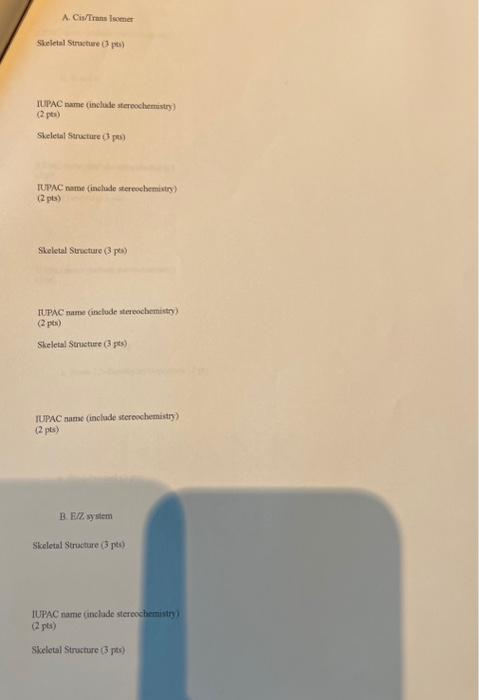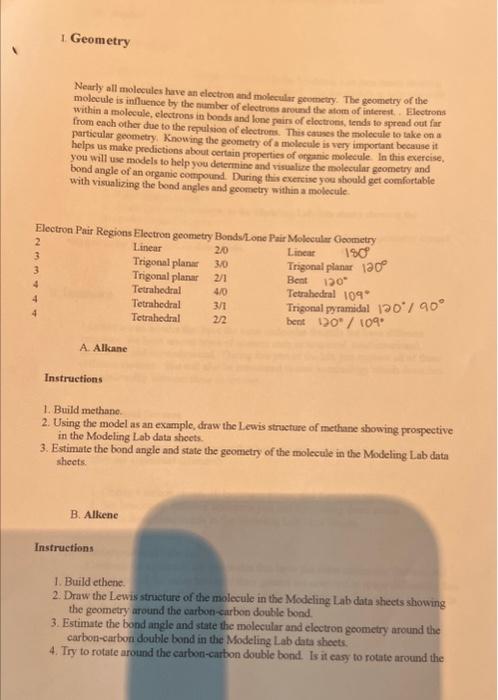help please

A. Cis/rans loomer Sheletal Stracture (3, pai) IUPAC name (include stereochermatry). (2p+i) Sikeletal Saructure (3 pas) ITPAC name (inchade stereochemisto) (2 pts) Siveletal Structure (3 pa) IUPAC name (inslude stereocbemistry) (2p(si)) Skeletal Strusture (3 pre) IVPAC nanse (inclade stercochemisty) (2) pts) B. Flarsyslem Skeletal Strocture (3 jat) IUPAC name (inclade sterecciermistry) (2) pli) Skcletal Structure (3 Tts ) IUPAC name (include stereochemistry) (2 pts) C.R and S Skeletal Structure ( 3 pts) IUPAC name (include stereochemistry) ( 2pt) Skelctal Structure ( 3pts) IUPAC name (include stereochemistry) (2pt) Daw the following a. Trans-1, 3-dimethylcyclopentane (2 pt) b (R)-2-tuanal (3 pt) Introduction: When constructing models of organic molecules you should gain a feeling for the shapes of the real molecules. Real molecules are actually more flexible than the models you will build. In order to be able to construct a model correctly, you must either have carefully written instructions, or else you must know the exact order in which the atoms are bonded. Sometimes only the IUPAC name need be learned. In many cases one also needs to know the common name as well as the IUPAC name to be able to converse with others. The IUPAC name is different from the parent name in that the IUPAC name is directly related to the structure of the molecule however many times the common name does not. The IUPAC always consist of a parent name and suffix. Many times substituents and stereochemical designation are also included in the IUPAC name. When writing the IUPAC name for a molecule one must follow the rules below: 1. Identify the longest carbon chain. 2. Give the parent name based on the longest carbon chain. 3. End the parent name in the suffix that represent the functional group given in the molecule. 4. Include substituents and stereochemical designation in name when needed. Nearly all molecules have an electroe and molecular geometry. The geometry of the molocule is influence by the number of electrons apound the atom of interent. Flectrons within a molocule, electrons in bonds and lone pairs of eloctrons, tends te spread out far from each other due to the repulsion of electrons. This causes the molecule to take on a particular geometry. Knowing the geometry of a molecule is very important because it helps us make predictions about certain propertics of ongmic molecule. In this exercise, you will use models to help you deternine and visualize the molecular geometry and bond angle of an organie contpound. During this exercise you should get comfortable. with visualizing the bond angles and geornetry within a molecule. A. Alkane Instructions 1. Build methane. 2. Using the model as an example, draw the Lewis straeture of methane showing prospective in the Modeling Lab data sheets. 3. Estimate the bond angle and state the geometry of the molecule in the Modeling Lab data sheets. B. Alkene Insfructions 1. Build ethenc. 2. Draw the Lewis structure of the molecule in the Modeling Lab data sheets showing the geometry around the carbon-carbon double bond. 3. Estimate the bond angle and state the molecular and electron geometry around the carbon-carbon double bond in the Modeling Lab data sheets. 4. Iry to rotate around the carbon-carbon double bond. Is it easy to rotate around the A. Cis/rans loomer Sheletal Stracture (3, pai) IUPAC name (include stereochermatry). (2p+i) Sikeletal Saructure (3 pas) ITPAC name (inchade stereochemisto) (2 pts) Siveletal Structure (3 pa) IUPAC name (inslude stereocbemistry) (2p(si)) Skeletal Strusture (3 pre) IVPAC nanse (inclade stercochemisty) (2) pts) B. Flarsyslem Skeletal Strocture (3 jat) IUPAC name (inclade sterecciermistry) (2) pli) Skcletal Structure (3 Tts ) IUPAC name (include stereochemistry) (2 pts) C.R and S Skeletal Structure ( 3 pts) IUPAC name (include stereochemistry) ( 2pt) Skelctal Structure ( 3pts) IUPAC name (include stereochemistry) (2pt) Daw the following a. Trans-1, 3-dimethylcyclopentane (2 pt) b (R)-2-tuanal (3 pt) Introduction: When constructing models of organic molecules you should gain a feeling for the shapes of the real molecules. Real molecules are actually more flexible than the models you will build. In order to be able to construct a model correctly, you must either have carefully written instructions, or else you must know the exact order in which the atoms are bonded. Sometimes only the IUPAC name need be learned. In many cases one also needs to know the common name as well as the IUPAC name to be able to converse with others. The IUPAC name is different from the parent name in that the IUPAC name is directly related to the structure of the molecule however many times the common name does not. The IUPAC always consist of a parent name and suffix. Many times substituents and stereochemical designation are also included in the IUPAC name. When writing the IUPAC name for a molecule one must follow the rules below: 1. Identify the longest carbon chain. 2. Give the parent name based on the longest carbon chain. 3. End the parent name in the suffix that represent the functional group given in the molecule. 4. Include substituents and stereochemical designation in name when needed. Nearly all molecules have an electroe and molecular geometry. The geometry of the molocule is influence by the number of electrons apound the atom of interent. Flectrons within a molocule, electrons in bonds and lone pairs of eloctrons, tends te spread out far from each other due to the repulsion of electrons. This causes the molecule to take on a particular geometry. Knowing the geometry of a molecule is very important because it helps us make predictions about certain propertics of ongmic molecule. In this exercise, you will use models to help you deternine and visualize the molecular geometry and bond angle of an organie contpound. During this exercise you should get comfortable. with visualizing the bond angles and geornetry within a molecule. A. Alkane Instructions 1. Build methane. 2. Using the model as an example, draw the Lewis straeture of methane showing prospective in the Modeling Lab data sheets. 3. Estimate the bond angle and state the geometry of the molecule in the Modeling Lab data sheets. B. Alkene Insfructions 1. Build ethenc. 2. Draw the Lewis structure of the molecule in the Modeling Lab data sheets showing the geometry around the carbon-carbon double bond. 3. Estimate the bond angle and state the molecular and electron geometry around the carbon-carbon double bond in the Modeling Lab data sheets. 4. Iry to rotate around the carbon-carbon double bond. Is it easy to rotate around the











